What's down with rail in Aotearoa?
The last year has not been a good one for rail patronage in Aotearoa. So what's up and is it going to get better anytime soon?
The headline numbers
It’s annual report season in Aotearoa and the news is not as good as it could be for passenger rail across the motu. Some key figures for the 2024/2025 financial year tell the story when compared to the previous year:
KiwiRail Great Journeys of NZ - 186,000 trips - up 3%
Regional trains - Capital Connection and Te Huia - 173,000 trips - down 9%
Wellington urban rail - 10.33 million - down 8.6%
Auckland urban rail - 13.8 million - down 0.04 %
This is a drop of 1,037,866 (or 4.2%) from 25,523,738 rail journeys in the 2023/2024 financial year (July to June) to 24,485,872 rail journeys in the 2024/2025 financial year.
How did this come to pass?
So how did we misplace over a million rail trips? And is this going to be better anytime soon?
Firstly, the classic reason is - it’s the economy stupid! This has particularly impacted the nation’s capital with Te Whanganui-ā-Tara/ Wellington hard hit by a government laser focused on liberating public servants from paid employment. In spite of Government exhortations, people are still working from home having their Teams calls with colleagues often also working from home, rather than having Teams call with colleagues working on the next floor up. (FYI, that was a Whakataki Times insight. I highly recommend following them on Instagram as they have their satirical finger on the pulse of the Kiwi public service).
So while the economy is a high-level reason for people to generally travel less, not just by rail, there are more fine-grained reasons as well as reason for optimism that there is light at the end of proverbial tunnel. I will get into this in the following sections.
Transmission Gully
The opening of the Transmission Gully Motorway to the north of Wellington has, to the surprise of absolutely nobody, induced trips to road that previously took place by public transport. This is not helped by ongoing speed restrictions on the Kāpiti Line, including to rebuild some of the seawall around Porirua Harbour. This contributed to a 12.3% decline in Kāpiti Line punctuality to 71.1% in the 2024/2025 financial year when compared with the previous year.
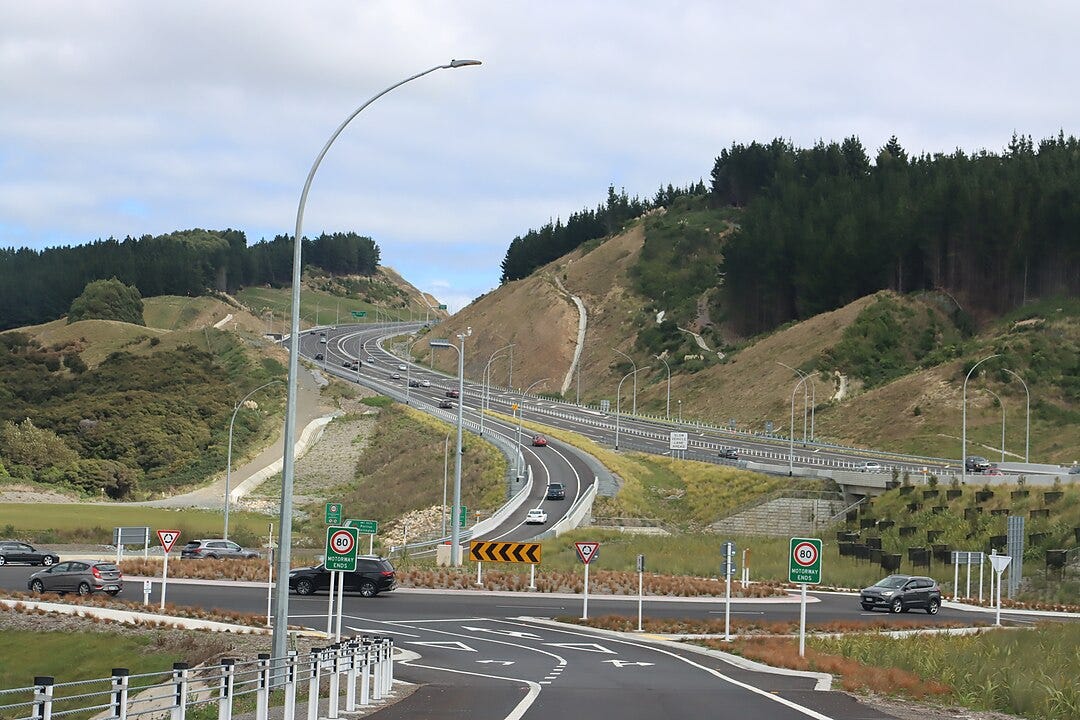
As a consequence of Transmission Gully, patronage on all Wellington rail stations around or to the north of the Transmission Gully Motorway has dropped. So while car commuters are enjoying a faster trip to the back of the queue at the Linden merge, where Transmission Gully joins the Porirua Motorway, Jevons Paradox will come to the rescue as the induced traffic makes car trips unattractive and trips will return to rail which can and does offer much more reliable travel times.
So a combination of induced demand from roading investment coincided with a sustained decline in the punctuality of the Kāpiti rail line made for a fatal combination for Kāpiti Line rail patronage which declined by 9.2% in the 2024/2025 financial year when compared with the previous year.
Wairarapa Line woes
If you think things are bad on the Kāpiti Line, they are even worse on the Wairarapa Line, currently undergoing a much overdue modernisation to address decades of underinvestment. In its worst month, barely 5% of Wairarapa Line trains were on time, meaning passengers had just a one in twenty chance of getting to the end of the line less than five minutes late.
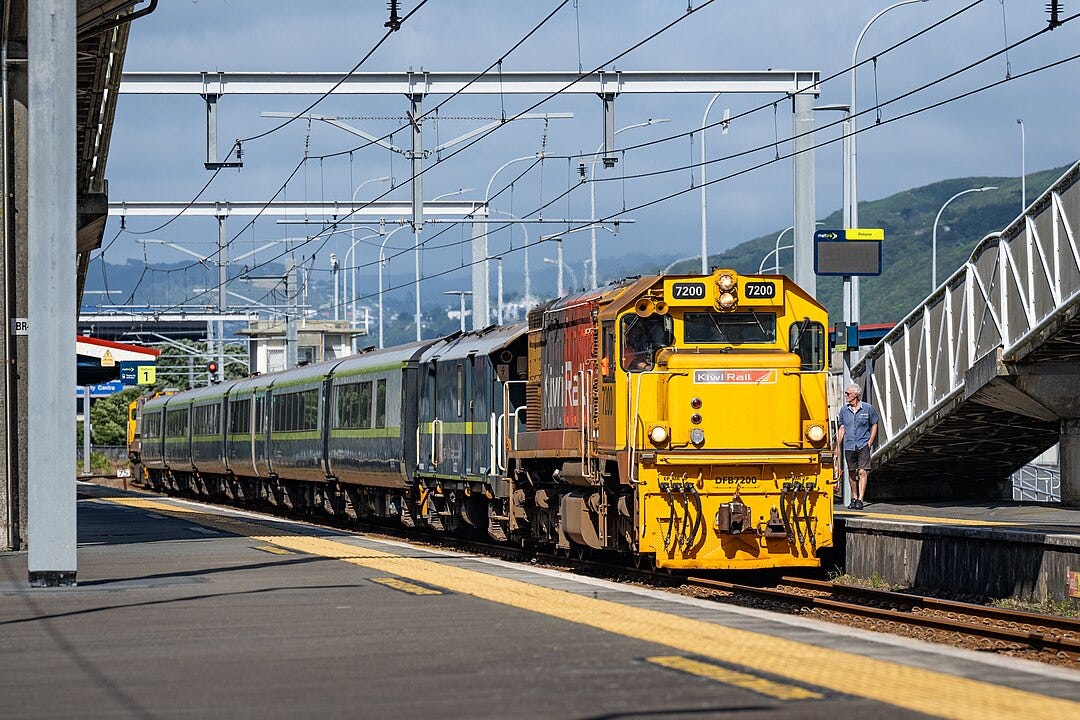
The issues on the line have been manifold with anything from misaligned tracks leading to train vibrations through to crewing shortages, locomotive breakdowns and speed restrictions due to substandard track quality. In the 2024/ 2025 financial year, only 41.3% of Wairarapa Line trains were on time. But that was a 17.8% improvement on the 2023/2024 financial year when only 23.5% of trains were on time.
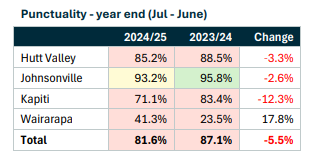
As a consequence, patronage on the Wairarapa Line fell by 14% to 518,930 in the 2024/ 2025 financial year. Given the sheer scale of the issues experienced on the line, Wairarapa Line passengers deserve a medal for their resilience in the face of such adversity.
Overall, it was not a great year for rail patronage in Aotearoa’s capital with Wellington’s rail network experiencing an 8.6% decline in patronage from 11,302,057 to 10,326,872, a reduction of 975,185 passenger trips. Not only is this bad news for rail, it is burning a hole through Greater Wellington’s wallet as the rail is on a gross contract, with the revenue risk sitting with the regional council. Wellington’s total public transport revenue for the 2024/2025 financial year was $36,186,323 which is $14,047,745 less than the forecast fare revenue of $50,234,068. Much of this drop in revenue is due to lower than forecast rail patronage.
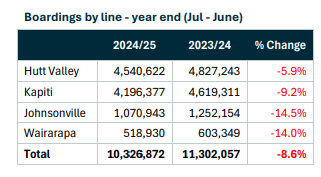
So Wellington really has had a trifecta of misfortune:
Significant cuts in the public sector workforce naturally most heavily impacting the capital, accentuating the drop in patronage experienced on longer distance rail journeys from hybrid work becoming commonplace.
A decline in performance of the Kāpiti Line unfortunately coinciding with the opening of the Transmission Gully Motorway, accentuating the level of induced demand on the motorway, and
Ongoing reliability and punctuality issues on the Wairarapa Line, where the end to end journey time is 1 hour 40 minutes when the train is on time.
Tāmaki Makaurarau’s Rail Network Rebuild
The nation’s economic engine, Tāmaki Makaurau/ Auckland, with a third of the nation’s population, was spluttering in the 2024/ 2025 financial year with an unemployment rate of 6.1% in the June 2025 quarter, the highest of all regions in New Zealand and an increase from 4.6% in the same quarter of the previous year.
At the same time, the city’s rail network was undergoing ongoing radical surgery to get it into a fit state for the opening of City Rail Link in 2026. This includes 96 days of full or partial rail network closures during 2025.
Auckland Transport stated in its 2022/2025 Annual Report that:
“ passenger growth was constrained by ongoing hybrid working and reduced confidence in the rail network due to the KiwiRail Network Renewal programme. Rail line closures in 2024 led to an estimated 580,000 fewer passenger trips.” Auckland Transport Annual Report 2024/2025, page 29
So what is remarkable in Auckland is that rail patronage held up as well as it did with patronage effectively static. This will have been helped by the completion of significant parts of the rail network rebuild, the completion of Papakura to Pukekohe electrification leading to the resumption of passenger service to Pukekohe in February 2025, as well as the completion of the Third Main on the North Island Main Trunk link between Wiri and Westfield junctions significantly reducing conflicts between passenger and freight services on one of the busiest part of the national rail network.
Te Huia travails
Te Huia, the regional train between Kirikiroa/ Hamilton and Tāmaki Makaurau/ Auckland, was collateral damage from Auckland’s Rail Network Rebuild. Due to this, Te Huia has been unable to operate during school holidays when the most intense Rail Network Rebuild work takes place with full line closures. This is ironically the time when lots of people take annual leave and are available to do the sorts of trips that Te Huia provides for, including a nearly month long shutdown during the forthcoming Christmas New Year holidays, the time that Aotearoa traditionally shuts down and heads away on holiday.
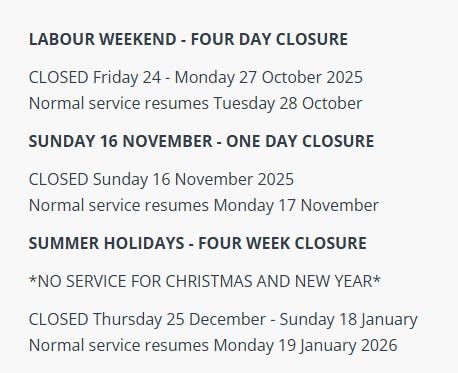
Largely as a consequence of reduced services due to Auckland’s Rail Network Rebuild, Te Huia patronage fell 9.3% from 79,965 in the 2023/2024 financial year to 72,580 in the 2024/2025 financial year1.
It would be an absolute travesty if Waka Kotahi/ New Zealand Transport Agency uses this decline in patronage as an excuse for not continuing to provide national funding for Te Huia in its forthcoming decisions on Te Huia’s future. The failings of Auckland’s rail network are to blame and of course Auckland contributes absolutely no funding support to Te Huia even though Auckland benefits from Te Huia’s customers spending money in Auckland and 21% of Te Huia’s customers being Aucklanders.
Capital Connection
Transparency and Capital Connection rarely appear together in a sentence. But from reading the KiwiRail 2024/2025 Annual Report2 and deducting publicly available Te Huia patronage data, you can work out that Capital Connection patronage declined by 7.3% from 109,000 in 2023/2024 to 101,000 in 2024/2025.
Prognosis positive
While what goes before was hardly a stellar year for passenger rail, as I said at the start of the piece it’s the economy stupid. And the kiwi economy is hardly stellar at present. Not helped by the New Zealand government contributing to this by making a significant portion of the Wellington public sector workforce unemployed.
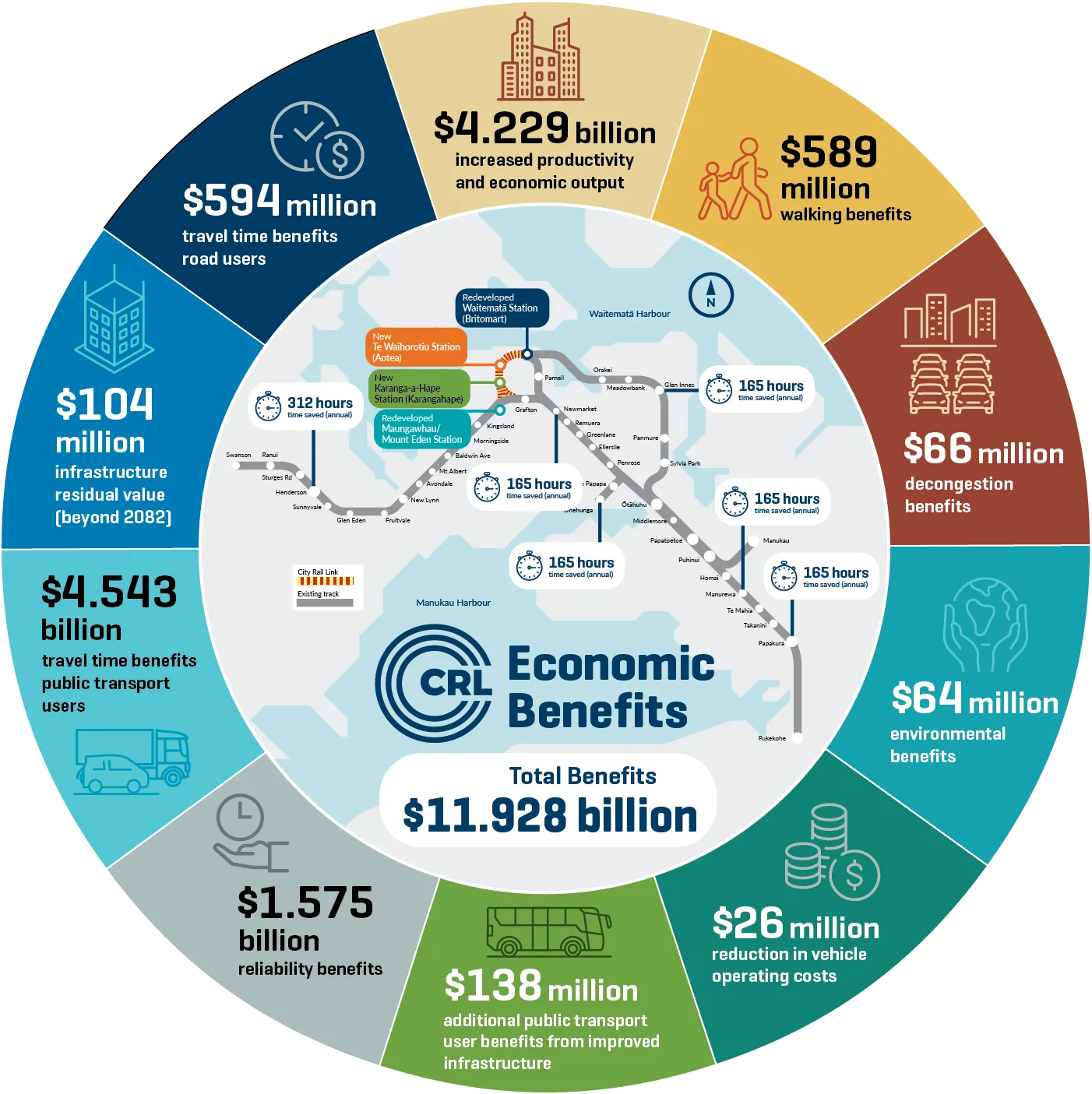
Economies can and do turn around, in spite of the best efforts of the New Zealand government to prevent this. Transmission Gully will before too long turn into a glorified peak period carpark; the Wairarapa Line modernisation will be complete and new hybrid trains will be running on the Wairarapa and Manawatū lines by the end of the decade. And of course City Rail Link will open in Tāmaki Makaurau in 2026, doubling the number of people with half an hour’s travel from the city centre with two new and one upgraded city centre stations making virtually the entire city centre within 10 minutes walk of a train station.
So in spite of a bad year, the future of rail is bright. Very bright.
Te Huia Patronage Data, Te Huia website, accessed on 14th October 2025
KiwiRail 2024/2025 Annual Report, page 23


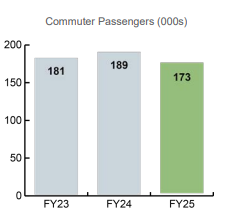
Yes there’s certainly going to be a massive rebound with CRL, the Wellington upgrades and the new lower North Island trains. But Te Huia might be in trouble, with a former Nat MP now elected mayor in Hamilton and a new bunch of Waikato regional councillors who beat the “low rates” drum.
Hopefully the new hybrid trains in Wellington will show a (presumably) faster journey time will pull in more passengers. On the Kapiti line , as well as the Wairarapa line. Maybe this could lead to some peak hour express trains , to counter the gully's time advantage. There is always the single track section to slow things down , but at least the 70 km/hr curves south of Pukerua bay could be eased to save a few extra minutes.